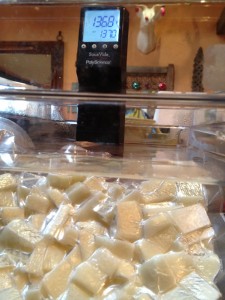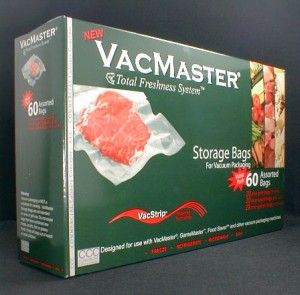
Sous Vide – plastics
The concern about plastics is that they have been found to contain chemicals that can act “like” hormones and have been implicated in low sperm counts, endocrine sensitive tumors (breast, ovary), and birth defects.
In a previous article, I discussed BPA. This resin is used in almost all plastics, although has been taken out of baby bottles. The bags used for Sous Vide cooking are typically BPA free- if they are not, then you need to find a better bag (and lots of good ones are out there).
Plastic Chemistry
First a bit of plastic chemistry; plastics are not one uniform product. They typically are petroleum based, although they can be made from sugar or corn. There are many types of plastics out there, and some of them break down at lower temperatures, some resist temperature breakdown, some are inert to people. All plastics are not the same, and there are a wide variety of uses for the plastics. To quote the plastics organization:
“Copper, silver and aluminum are all metals, yet each has unique properties. You wouldn’t make a car out of silver or a beer can out of copper because the properties of these metals are not chemically or physically able to create the most effective final product. Likewise, while plastics are all related, each resin has attributes that make it best suited to a particular application. Plastics make this possible because as a material family they are so versatile.”
It isn’t the plastic itself that is an issue but something called “plasticizer,” the substance that makes plastic soft and supple. Plasticizers are made of molecules smaller and more mobile than the macromolecules in the plastics they condition. So besides BPA there are other plasticizers which we broadly call phthalates. Phthalates are used in a large variety of products, from enteric coatings of pharmaceutical pills and nutritional supplements to viscosity control agents, gelling agents, film formers, stabilizers, dispersants, lubricants, binders, emulsifying agents, and suspending agents – in other words, phthalates are in almost everything, and byproducts of them are commonly found in humans. Since the Phthalates do not have a strong bond with plastics they easily enter into foods. Phthalates in very large doses, like BPA, can compete with hormones, in this case testosterone.
But most plastic wraps, zip-lock bags, freezer bags, and Sous Vide bags are free of pthalates, and BPA. The change from polyvinylidene chloride to polyethylene was for safety, but it did make the “cling” wrap cling less. Polyethelene is stable at low temperature Sous Vide cooking.
Food Grade Plastics:
 |
PET or PETE (polyethylene terephthalate) is a clear, tough polymer with exceptional gas and moisture barrier properties. PET’s ability to contain carbon dioxide (carbonation) makes it ideal for use in soft drink bottles.Examples: Soft drink bottles, detergent bottles |
 |
HDPE (high density polyethylene) is used in milk, juice and water containers in order to take advantage of its excellent protective barrier properties. Its chemical resistance properties also make it well suited for items such as containers for household chemicals and detergents. Most five gallon food buckets are made from HDPE.Examples: Milk bottles, shopping bags |
 |
Vinyl (polyvinyl chloride, or PVC) provides excellent clarity, puncture resistance and cling. As a film, vinyl can breathe just the right amount, making it ideal for packaging fresh meats that require oxygen to ensure a bright red surface while maintaining an acceptable shelf life.Examples: Plastic food wrap, shrink wrap, garden hoses, shoe soles |
 |
LDPE (low density polyethylene) offers clarity and flexibility. It is used to make bottles that require flexibility. To take advantage of its strength and toughness in film form, it is used to produce grocery bags and garbage bags, shrink and stretch film, and coating for milk cartons.Examples: Squeeze bottles, dry cleaning bags |
 |
PP (polypropylene) has high tensile strength, making it ideal for use in caps and lids that have to hold tightly on to threaded openings. Because of its high melting point, polypropylene can be hot-filled with products designed to cool in bottles, including ketchup and syrup. It is also used for products that need to be incubated, such as yogurt. Many Cambo, Tupperware and Rubbermaid food storage containers are made from PP.Examples: Bottle caps, take-out food containers, drinking straws |
 |
PS (polystyrene), in its crystalline form, is a colorless plastic that can be clear and hard. It can also be foamed to provide exceptional insulation properties. Foamed or expanded polystyrene (EPS) is used for products such as meat trays, egg cartons and coffee cups. It is also used for packaging and protecting appliances, electronics and other sensitive products.Examples: Plastic foam, packing peanuts, coat hangers |
 |
Other denotes plastics made from other types of resin or from several resins mixed together. These usually cannot be recycled. These may contain BPA in them, the other codes do not. |
Effect of Plastics on Flavor
The plastic does not change the flavor or the texture of Sous Vide foods. There is more flavor with Sous Vide cooking, as it is cooked at a low temperature.
Leaching
This is the term we see a lot. The thought that toxins will leach from plastic because it is heated and intimately contacting the food. Studies done with BPA containing bottles showed that increasing heat and time increases the ability of BPA to leach. However, the levels of BPA that leached were exceedingly low over time. What was noted: taking over 8 hours at high temperatures (higher than sous vide) were required to get levels that might be detectable above baseline. To re-emphasize, this was with BPA laden plastics.
The low temperature is not enough for “leeching” of any material out of the Sous Vide bags. There were a number of tests performed where plastics were heated to beyond boiling points, or in a microwave, and then the material tested on tissue culture cells, which showed an increase in growth pattern. There were a number of reasons this was a poor test- first because (a) the heat was higher than used for cooking Sous Vide (b) they did not differentiate between BPA free and BPA containing plastics (c) this was a breast cancer cell line, not normal cells that transform into cancer- thus it just showed an increase in the growth of a cancer cell – but not something that would transform a normal cell to cancer. They concluded the plastics contained some “estrogen” like effect – BPA will do that – but they did not have an assay for it. The estrogen effect was weaker than one would expect from someone being 10 pounds overweight.
Manufacturing of the Bag
Most bags have multiple layers built into them. Some have an outer layer of nylon, the others are typically layers of polyethylene which contain no BPA or phthalates. Polyethylene is inert, and in spite of looking, there has been no toxicity found with this plastic compound. The AMES test (checking for mutagenesis) was negative, and polyethylene has no estrogen-like compounds in it.
All that are sold in the United States meet the FDA standards. For the particular bag you use, you can contact the company directly to answer your safety concerns. Some companies, up front will tell you that their bags are BPA free and phthalate free (such as the bags from Sous Vide Supreme, VacMaster, Foodsaver). Other companies you have to dig on their websites or call them.

We checked with the major US sellers of Sous Vide bags – they are all BPA and Phthalate free.
In Summary
The worry about toxicity from BPA or phthalates is unwarranted with Sous Vide bags that are sold in the United States, and Zip-lock type bags (some use these for Sous Vide). There have been extensive tests performed on BPA plastics – and even with BPA it would take hours before amounts would leach into the food – and the results are less than what is found at baseline in a person.Other issues from plastic migration – such as estrogen-like compounds, have been investigated, but come from much higher temperature than Sous Vide, and confirms that when using a microwave the safest dishes are glass, not plastic. Heavy metals and antimony can leach from any plastic into water using PET bottles, but the level of those compounds was in the safe level by EU standard. Those tests were from water bottles that was sitting for days, and more heavy metals came out when exposed to higher temperatures – like 80C/176F , higher than used for most Sous Vide.
At this point, there is more danger from cooking on non-stick surfaces, drinking water from plastic bottles, or breathing city air than from consuming food cooked in the bags used for Sous Vide cooking. The concern that there would be harmful materials is understandable because of what we have learned about BPA and phthalates – NOT an issue with the Sous Vide bags noted. Please note other manufacturers of bags are free to comment in our section about their testing.
Sous Vide is a safe, effective, and tasty alternative method of cooking. We recommend this to our weight loss surgery patients as it provides cooking that is “fool-proof” and easy. In addition, by keeping meat moist, it allows them to enjoy most meats without having them become lodged in the narrow opening of a lap-band. Our next book will have more about how the body works with food, and some Sous Vide recipes. This cookbook called: JUST EAT! Recipes from a Surgeon: Shattering Myths About Food from a Weight Loss Doctor that Knows Your Body Inside and Out. (We expect to release the cookbook in Spring 2013.)
REFERENCES:
Migration of bisphenol A from plastic baby bottles, baby bottle liners and reusable polycarbonate drinking bottles. Kubwabo C, Kosarac I, Stewart B, Gauthier BR, Lalonde K, Lalonde PJ. Food Addit Contam Part A Chem Anal Control Expo Risk Assess. 2009 Jun;26(6):928-37. Pub Med ID 19680968
Endocrine disruptors in bottled mineral water: estrogenic activity in the E-Screen. Wagner M, Oehlmann J.J Steroid Biochem Mol Biol. 2011 Oct;127(1-2):128-35. PMID: 21050888
Other things that can come from plastics were in these bottled waters from PET bottles. Still, however, the levels were below the safe levels from standards.
PET bottle use patterns and antimony migration into bottled water and soft drinks: the case of British and Nigerian bottles. Tukur A, Sharp L, Stern B, Tizaoui C, Benkreira H.J Environ Monit. 2012 Apr;14(4):1237-47 PMID: 22402759
